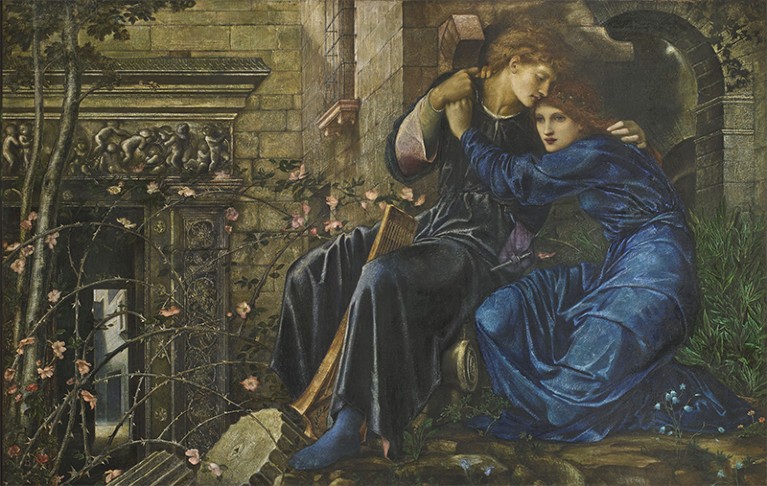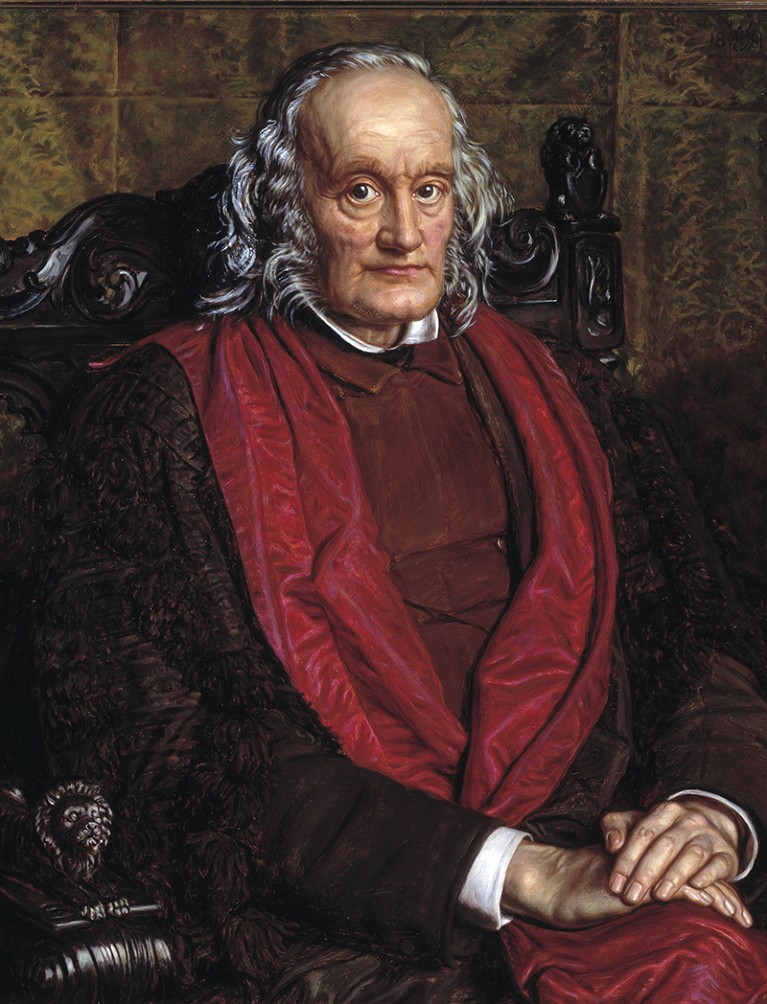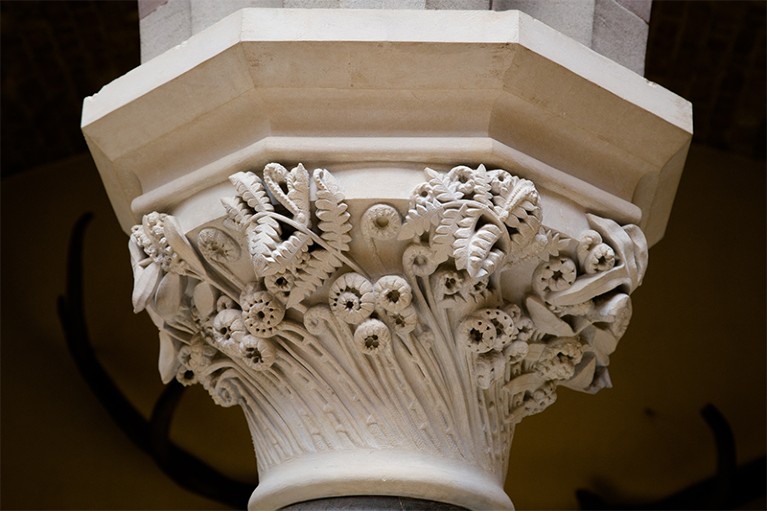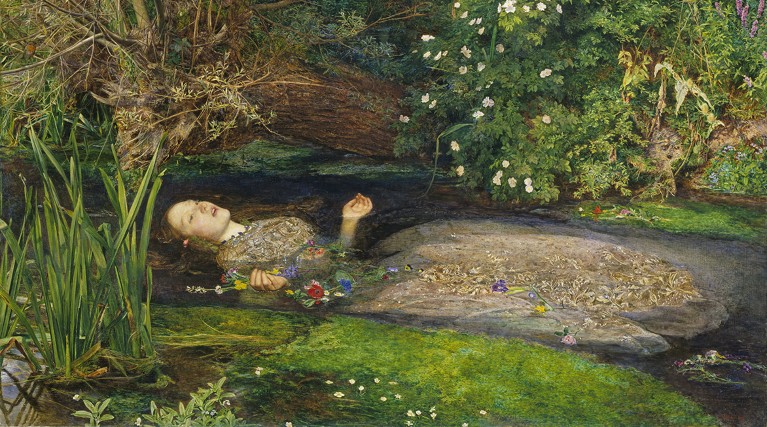Edward Burne-Jones Tate Britain, London. Until 24 February 2019.
Extraordinary advances in science, technology and industry shaped the Victorian age; alongside that grew a new experimentalism in literature and the arts. From 1848, the Pre-Raphaelite Brotherhood, a group of British artists founded by Dante Gabriel Rossetti, William Holman Hunt and John Everett Millais, began to weave science into their art. They sought a new aesthetic even as they called for art to model itself on science — and were championed by scientific luminaries from the comparative anatomist Richard Owen to physician Henry Acland.
The Pre-Raphaelites rejected the insistence of the Royal Academy of Arts in London that artists should learn by imitating the paintings of Raphael. Modern interest in the group has grown steadily since a revival among the counter-culture of the 1960s. That is newly reflected in a retrospective on the work of Edward Burne-Jones (who, with Rossetti and William Morris, formed the ‘second-wave’ Pre-Raphaelite movement) at Tate Britain in London. Burne-Jones’s paintings, such as the 1880s Briar Rose series featured in the exhibition, seem to open a window on an exquisitely romanticized fantasy world caught in moments of stillness. But John Ruskin, the era’s leading art critic and a serious amateur geologist and botanist, saw something else there. In 1884, he wrote that, although the brotherhood’s work might “seem to be the reaction of a desperate fancy … against the incisive scepticism of recent science”, they were in fact “a part of that science itself”. Ruskin supported the Pre-Raphaelites and knew them well.

Love Amongst the Ruins (1870–73) by Edward Burne-Jones.Credit: Private collection via Tate Britain
From the start, they insisted on working “from absolute data of fact” and acute observation, as the critic William Michael Rossetti — brother of Dante Gabriel and poet Christina Rossetti — explained in the magazine The Spectator in 1851. He noted that the group conducted “investigations” through art, and offered the public “unflinching avowal of the result”. A year previously, Pre-Raphaelite art critic Frederic George Stephens had spelt out the group’s commitment to these principles in its short-lived periodical The Germ. Stephens remarked that since the early 1800s, disciplines such as chemistry had made astonishing progress “by bringing greater knowledge to bear upon a wider range of experiment”, and pursuing precision. Why, he asked, shouldn’t the same methods benefit the arts’ “moral purposes”?
How did the group harness empirical methods to create its work? Take arguably the most famous Pre-Raphaelite painting, Millais’s Ophelia (1851–25). At first glance, this seems a sentimental portrayal of the tragic suicide of the character in William Shakespeare’s Hamlet. However, every plant depicted, from purple loosestrife to wild roses, is the product of more than three months of painstaking observation as Millais worked on the banks of the Hogsmill River in Surrey. Other artists had painted in the open air before, but never in such meticulously wrought detail.
This became a collective experiment to discover what painting, pushed to its limits, could reveal. Each new work would press further, recording exact effects of light and shade, as in Hunt’s 1851 The Hireling Shepherd; or ecological relationships and animal behaviour, as in the straying sheep of his 1852 Our English Coasts; or skin tones in full sunlight, as in Ford Madox Brown’s The Pretty Baa-Lambs (1851). Subjects were scrupulously researched. Hunt visited Jerusalem and the Dead Sea to study the landscape, people and latest archaeological findings for his paintings of the life of Jesus.
Looking more closely at Ophelia, we see a study of physical and psychological phenomena. Millais asked his model, Elizabeth Siddall — poet, artist, and later Dante Gabriel Rossetti’s wife — to lie in a bath fully dressed. Candles were set under the bath for warmth. Millais’s concentration was such in his epic eight-hour bout of painting that he failed to notice when they went out; Siddall caught a severe chill and he paid the doctor’s bill. Siddall thus paid a price for Millais’ ‘laboratory conditions’, but the method did enable him to capture how hair and fabric float on and underneath the surface of water.
Ophelia’s expression in the painting is also revealing. The Pre-Raphaelites were rightly scathing about the state of psychology in 1850, when phrenology and physiognomy still passed as sciences. Stephens called it “dry operose quackery ... mere chaff not studied from nature, and therefore worthless, never felt, and therefore useless”. They set out to study the mind through art instead, refining their designs as they thought through the mental states of their subjects. An early drawing for Ophelia, now in the Plymouth City Museum, is melodramatic. In the finished painting, we see a much more subtle analysis: Ophelia subdued by despair, sinking into unconsciousness as she drowns. When Stephens argued that scientific methods could advance art’s moral purpose, this is what he meant: it helps us to understand humanity and nature.

Richard Owen, founder of the Natural History Museum in London, painted by William Holman Hunt in 1881.Credit: NHM, London/Bridgeman Images
The art establishment was crushing in its opposition to the group, as were mainstream journalists. Charles Dickens called Millais’s provocative 1849–50 painting Christ in the House of His Parents “odious, repulsive, and revolting”. By contrast, many Victorian scientists supported the brotherhood. The naturalist William Broderip, who bought The Hireling Shepherd, introduced Hunt to Owen, founder of the Natural History Museum in London (and coiner of the word ‘dinosaur’). Owen became a staunch advocate of the Pre-Raphaelites, and delighted in showing Millais and his children around the British Museum’s natural-history collections. In 1881, Hunt painted the magnificent portrait of Owen now in the Natural History Museum.
Acland, one of Owen’s students and from 1858 the Regius Professor of Medicine at the University of Oxford, was even more central to the movement. When he and Ruskin campaigned in the 1850s for a natural-history museum in Oxford, Acland declared that it would be decorated on Pre-Raphaelite principles. The stonework was based on real plants and animals, carved in minute detail by unsung heroes of Victorian sculpture John and James O’Shea. The stone columns around the central court were geological samples drawn from quarries around Britain to illustrate different periods of Earth’s history. The court was surrounded by statues of scientists at work, from Galileo Galilei to James Watt. Rossetti advised on the project; Ruskin and Siddall, among others, contributed designs. Thomas Woolner, the brotherhood’s only sculptor, with the group’s close collaborators John Lucas Tupper and Alexander Munro, fashioned the sculptures. The Oxford University Museum of Natural History stands as one of the best and most surprising collections of Victorian public sculpture, and the only one dedicated to science.

Ferns carved by James O’Shea top a column at the Oxford University Museum of Natural History.Credit: OUMNH
Woolner went on to collaborate with the architect Alfred Waterhouse. When Waterhouse built the commanding Natural History Museum in London for Owen in the 1870s, they again applied Pre-Raphaelite principles. Owen supplied Waterhouse with specimens from the vivarium and illustrations of extinct animals as models for the terracotta menagerie that adorns the museum’s facade. Waterhouse paid tribute to Owen by including ancient fauna he had described, such as the archaeopteryx and the palaeotherium.
It was also Woolner who made the Pre-Raphaelites’ most direct contribution to science. When carving a bust of Charles Darwin (now in the herbarium at the University of Cambridge), Woolner alerted the biologist to a small protuberance sometimes visible inside the rim of the human ear, known as the auricular tubercle. In the 1840s, when devising a statuette of Puck from Shakespeare’s A Midsummer Night’s Dream, Woolner had observed that the feature also appears in monkeys, as pointed ears. Both Darwin and Woolner recognized this physiological phenomenon as evidence of human evolution from earlier primates, and Darwin — dubbing it the ‘Woolnerian tip’ — mentioned it in The Descent of Man (1871).
Woolner finished the bust in 1869. The same year, the astronomer Norman Lockyer founded a new periodical — Nature. Lockyer had Pre-Raphaelite connections, too: he had worked with William Rossetti on an earlier journal, The Reader; befriended Hunt; and employed Pre-Raphaelite landscape painter John Brett to accompany an expedition to Sicily to study the solar eclipse in 1870. In 1878, Lockyer wrote a series of articles on ‘Physical Science for Artists’, setting out guidance in optics and assessing paintings from the latest Royal Academy exhibition on grounds of scientific accuracy. In Nature, Lockyer held artists to exacting scientific standards, just as Stephens had done in The Germ.
The Pre-Raphaelites launched the most radical and ultimately the most influential Victorian art movement, inspiring the European symbolists and the Arts and Crafts movement led by Burne-Jones’s great associate, William Morris. They also took their lead from — and shaped the culture of — Victorian science, and affected its legacy to this day.


 Beatrix Potter: A scientist's eye
Beatrix Potter: A scientist's eye
 The wilder side of Edward Lear
The wilder side of Edward Lear
 Life in stone
Life in stone








